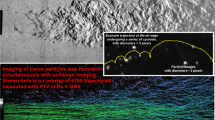Abstract
A horizontally oriented cylindrical tumbler, filled at variable depth with a monoplane of uniform cylindrical media, was rotated at various constant speeds. Resultant motion was captured using a high-speed camera. The images were post-processed with particle tracking velocimetry and image correlation algorithms in order to estimate each particle’s translational and rotational velocity. The particle interactions were then characterized into distance groups based on non-dimensional flow characteristics, where similarities were found with transitions between slip/no-slip and rotation/no-rotation conditions. The results of the particle interactions show rotational chains as analogous to translational force chains. The interactions demonstrated that occurrences of no-slip, no-rotation behavior correspond to areas of confined translational motion. No-slip rotation behavior was lower in areas of high interaction and higher in developing flow areas.
Graphical Abstract












Similar content being viewed by others
References
Bendicks C (2011) Improved 3-D particle tracking velocimetry with colored particles. J Signal Inf Process 02(02):59–71
Brandrup J, Immergut EH, Abe A, Bloch DR (1999) Polymer handbook, vol 89. Wiley, Hoboken, pp V87–V90
Brevis W, Nino Y, Jirka GH (2011) Integrating cross-correlation and relaxation algorithms for particle tracking velocimetry. Exp Fluids 50(1):135–147
Calvetti F, Combe G, Lanier J (1997) Experimental micromechanical analysis of a 2D granular material: relation between structure evolution and loading path. Mech Cohes Frict Mater 2(2):121–163
Cambou B (1998) Micromechanical approach in granular materials. Springer, Vienna, pp 171–216
Chen P, Ottino JM, Lueptow RM (2008) Subsurface granular flow in rotating tumblers: a detailed computational study. Phys Rev E 78:021303
Chou SH, Hu HJ, Hsiau SS (2016) Investigation of friction effect on granular dynamic behavior in a rotating drum. Adv Powder Technol 27(5):1912–1921
Christov IC, Ottino JM, Lueptow RM (2011) From streamline jumping to strange eigenmodes: bridging the Lagrangian and Eulerian pictures of the kinematics of mixing in granular flows. Phys Fluids 23(10):103302
Deng T, Bingley MS, Bradley MSA (2004) The influence of particle rotation on solid particle erosion rate of metals. Wear 256:1037–1049
Duong NP, Hosoi AE, Shinbrot T (2004) Periodic knolls and valleys: coexistence of solid and liquid states in granular suspensions. Phys Rev Lett 92:22
Duran J (2012) Sands, powders, and grains: an introduction to the physics of granular materials. Springer, Berlin, pp 27–52
Evonik Cyro, LLC Acrylite 2015 decorative plastic glazing. Arcat Inc. Section 08 84 13
Goldsmith J (2012) Particle image velocimetry and its applications to granular media. Worcester Polytechnic Institute, Worcester
Haff PK (1994) Granular matter: discrete mechanics. Springer, New York, pp 141–160
Hidalgo RC, Grosse CU, Kun F, Reinhardt HW, Herrman HJ (2002) Evolution of percolating force chains in compressed granular media. Phys Rev Lett 89:205501
Hill KM, Khakhar DV, Gilchrist JF, McCarthy JJ, Ottino JM (1999) Segregation-driven organization in chaotic granular flows. Proc Natl Acad Sci 96(21):11701–11706
Homeniuk DL, Nobes DS, Wilson DJ (2010) Three-dimensional particle tracking velocimetry. The Canadian Society for Mechanical Engineering, University of Alberta, Edmonton
Jain N, Ottino JM, Lueptow RM (2002) An experimental study of the flowing granular layer in a rotating tumbler. Phys Fluids 14:2
Krevelen V, Willem D, Nijenhuis KT (2009) Properties of polymers: their correlation with chemical structure; their numerical estimation and prediction from additive group contributions. Elsevier, New York City
Lin J, Wu W (2017) A general rotation averaging method for granular materials. Granul Matter 19(3):44
Lorenz A, Tuozzolo C, Louge MY (1997) Measurements of impact properties of small, nearly spherical particles. Exp Mech 37:292–298
Lueptow RM, Arkonur A, Shinbrot T (2000) PIV for granular flows. Exp Fluids 28:183–186
Mardiansyah Y, Khotimah SN, Viridi S (2016) Characterization of motion modes of pseudo-two dimensional granular materials in a vertical rotating drum. In: Journal of physics: conference series, vol 739, no 1. IOP Publishing, p 012148
Meier SW, Lueptow RM, Ottino JM (2007) A dynamical systems approach to mixing and segregation of granular materials in tumblers. Adv Phys 56(5):757–827
Myung IJ (2003) Tutorial on maximum likelihood estimation. J Math Psychol 47:90–100
Pignatel F, Asselin C, Krieger L, Christov IC, Ottino JM, Lueptow RM (2012) Parameters and scalings for dry and immersed granular flowing layers in rotating tumblers. Phys Rev E 86:011304
Pohlman NA, Ottino JM, Lueptow RM (2009) Unsteady granular flows in a rotating tumbler. Phys Rev E 80:031302
Ristow GH (1994) Granular dynamics: a review about recent molecular dynamics simulations of granular materials. In: Stauffer D (ed) Annual reviews of computational physics, vol 1. World Scientific Publishing Co., Pte. Ltd., Singapore, pp 275–308
Ristow GH (2000) Pattern formation in granular materials, No 164. Springer, Berlin, pp 130–144
Romero V (2012) Numerical modeling of granular flows in rotary kilns. Delft University of Technology, Literature Survey
Rosato A, Strandburg KJ, Prinz F, Swendsen RH (1987) Why the Brazil nuts are on top: size segregation of particulate matter by shaking. Phys Rev Lett 58(10):1038
Ulissi F, Ippolito I, Calvo A (2009) PIV technique applied to granular flows in hoppers. In: Journal of physics: conference series, vol 166
Valle MR (2012) Numerical modeling of granular flows in rotary kilns
Warr S, Jacques GTH, Huntley JM (1994) Tracking the translational and rotational motion of granular particles: use of high-speed photography and image processing. Powder Technol 81:41–56
Zhou B, Huang R, Wang H, Wang J (2013) DEM investigation of particle anti-rotation effects on the micromechanical response of granular materials. Granul Matter 15(3):315–326
Acknowledgements
This work was funded in part by NASA’s Wisconsin Space Grant Consortium.
Author information
Authors and Affiliations
Corresponding author
Electronic supplementary material
Below is the link to the electronic supplementary material.
Rights and permissions
About this article
Cite this article
Helminiak, N.S., Helminiak, D.S., Cariapa, V. et al. Resolving the angular velocity of two-dimensional particle interactions induced within a rotary tumbler. J Vis 21, 779–793 (2018). https://doi.org/10.1007/s12650-018-0495-1
Received:
Revised:
Accepted:
Published:
Issue Date:
DOI: https://doi.org/10.1007/s12650-018-0495-1




